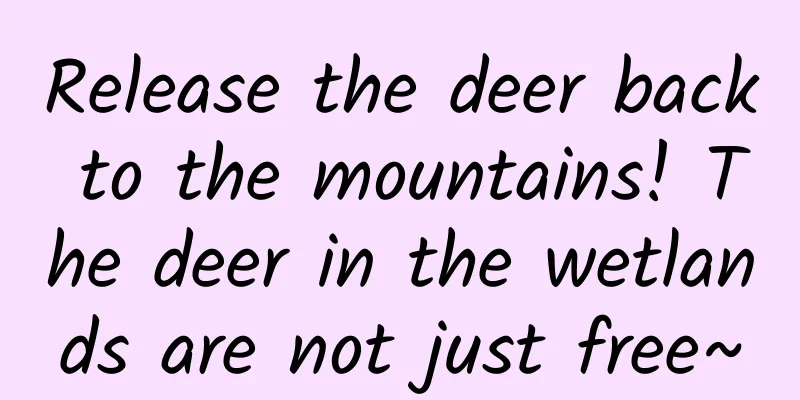Release the deer back to the mountains! The deer in the wetlands are not just free~

|
On September 5, we released a male musk deer into the wetlands along the Yangtze River. The musk deer was rescued by the police on September 2. After assessing its physical condition, we quickly released it back into the wild. Deer stuck on fence The musk deer was stuck on the fence of the community and couldn't get out. It was found by a resident and the police were called for rescue. I need to say in advance that except for the photos and videos of the release, the rest of the photos in this article do not belong to this musk deer. I didn't take too many photos because the time was tight and the task was heavy during the rescue process. The musk deer is timid and afraid of being startled. Although our actions were to rescue it, it was still scared to death. In order to reduce stress, we went to pick up the musk deer as soon as we received the call, and then quickly checked whether it had any external injuries. We then transferred it as quickly as possible to a cage that was covered on all sides where it would feel safe. After leaving some fresh leaves for it, we evacuated at the speed of light. Not the protagonist of this article, source: Another rescued musk deer The next morning we quietly went to observe the musk deer. Fortunately, it had recovered a little from the shock of the previous day and was able to eat some leaves normally. However, due to obstructions on all sides and too dim light, we were unable to take any photos of the musk deer, the protagonist of this film. After observation and evaluation, the musk deer was found to be in good condition and suitable for rapid return to the wild. The musk deer stayed at the rescue center for two days, and we began to prepare for its release. The deer swims fast, freedom is everywhere Before the release, Teacher Chen made precise arrangements for the release, preset each step and tool in the office, and arranged staff. In order to reduce the stress response of the musk deer, we tried to send in as few people as possible, and after entering, everyone performed their duties and ended the battle quickly. Rescuers put musk deer into transport boxes in the cage The first group of three people went in, caught the deer in a net bag, pinned him down, and put him in a restraint. Then, the second group carried the box into the cage, packed it, carried it out, and set off. The whole process was smooth and flowing, and we set off! Driving all the way to the destination, the deer was very quiet, so we looked back from time to time through the gap and saw its head shaking briskly in the box. It was in good spirits, not stressed or afraid. Our mentality also gradually calmed down from the initial tension. The roe deer on its way to release, the bulging wrinkles are its head This transport box is specially tailored for musk deer by professionals. It is designed according to the physiological characteristics of musk deer. The bottom of the box is soft, the box body is ventilated and breathable, and the top of the box is anti-collision, so there will be no friction or scratches. The musk deer cannot see outside and will not be too scared, which provides a good guarantee for the smooth transportation of musk deer. After arriving at the destination, we carried the box and chose an open place to put it down. After confirming that the musk deer is stable, we opened the zipper of the transport box. The protagonist of this article, the deer, finally appears~ After opening the transport box, the musk deer did not run away immediately. Instead, it hid in the box and looked around curiously, observing the surrounding environment. We held our breath and waited quietly for its next move. The sound of entering the water is so healing! A few minutes passed, and as if it had confirmed that there was no security threat around, the musk deer jumped out of the transport box and plunged into the water. The musk deer swam away from the water skillfully, quickly found a place with dense grass, quickly went ashore, ran into the grass, and disappeared from our sight. The protagonist, the deer, has swum away~ Listening to the faint rustling sounds in the grass getting farther and farther away, we carried the box and walked in the opposite direction, silently blessing it in our hearts, hoping that its life in the wild would be as free and unrestrained as it was when it entered the water. Musk deer need wetlands, and wetlands need musk deer We chose a wetland by the Yangtze River as the release site. Not the protagonist of this article, source: local area deer We have released a musk deer here before, and it has lived here for almost a year and is doing well. We have been accumulating and recording the activities of this musk deer and trying to analyze its behavior in the wild, hoping to get more specific information about its activities in the wild. At the same time, we are also evaluating this habitat, so we chose to release this musk deer here this time. Not the protagonist of this article, source: local area deer Musk deer need wetlands, and wetlands need musk deer. The disturbance of surrounding communities by herbivores is an important factor in the formation of healthy wetland plant communities. They can maintain the biodiversity in wetlands and indirectly affect the distribution and number of other organisms, such as insects, birds and other small mammals, through their feeding behavior, forming a complex food chain and food web. This multi-level ecological network makes the wetland ecosystem richer and more stable. Without the participation of herbivores in the ecosystem, the system will be incomplete. Not the protagonist of this article, source: local area deer Although there are actually quite a lot of musk deer in Nanjing, and you can see wild musk deer on many mountains at night, there are relatively few musk deer in the wetlands. Even so, we still hope that musk deer can have more opportunities to return to the wetlands. Combining reintroduction with scientific research can accumulate more basic information about species, and use this information to support the protection of species in the wild and protect more individuals. That should be a more meaningful wildlife rescue that is more in line with what zoos and rescue centers pursue. |
>>: Mayflies collectively "attack" the bridge, is it a sign of disaster or serious pollution?
Recommend
Android Aiyouman v2.1.3 All comics free to read_Taoduoduo
Android Aiyouman v2.1.3 All comics free to read_T...
How to write the beginning of a hit copy? Share 5 tips!
The human brain is like a machine. When the tempe...
Detailed explanation of the characteristics of information flow promotion channels such as Toutiao and Weibo!
If we want to do information flow promotion , cha...
A programmer who has always worked from 9 to 5
[[229247]] I’ve been thinking a lot lately about ...
Why did Emperor Wen of Han want to be alone in Bailuyuan?
On the morning of December 14, the State Administ...
The complaint rate ranks first in the industry. If you use Fliggy for travel, you as a consumer really need to be careful!
The National Day and Mid-Autumn Festival tourism ...
A must-read for mobile app developers: 14 ways to get your app accepted by the App Store
[[161389]] 【51CTO.com Quick Translation】For devel...
Domestic TV series become popular IPs and lead the fan economy
The cold front hit and the temperature dropped sh...
Xcodeghost ends, more than 300 popular apps infected with malicious programs, virus creator identified
Recently, the iPhone versions of many well-known ...
Gramineae looks like Gelsemium elegans, and the grass head looks like Trifolium aviculare! Before you dig wild vegetables in spring, learn to “recognize faces” first!
Gotu kola, cauliflower, fern, Houttuynia cordata,...
Xiaopeng G3 520i Smart Edition Review: The "Nokia" of the Automotive Industry Shake Up
Compared with century-old car companies, Xpeng Mo...
The gross profit margin of “fine camping” is as high as 70%! Is it profitable to open a camping base in 2022? Attached is the analysis of camping market prospects!
Affected by the epidemic, many people now choose ...
Operational case: The growth path behind "Zebra English" monthly revenue exceeding 100 million
What growth paths did Zebra English take to achie...
iOS/iPad OS 14.8.1 released: Apple recommends upgrading all older iPhone models
Not long after the official release of iOS 15.1, ...
Why can curved screens replace straight screens and become the symbol of high-end phones?
As a practitioner in the digital industry, I can ...




![[Case] How does an e-commerce app develop an operation and promotion strategy from scratch?](/upload/images/67cc4e8168971.webp)




